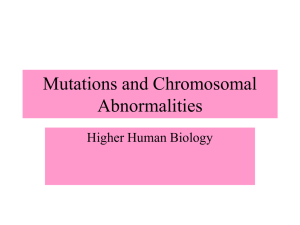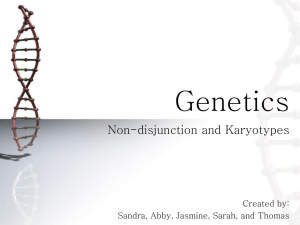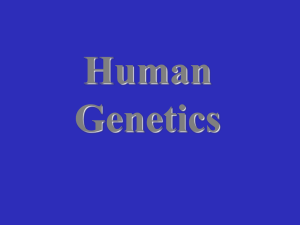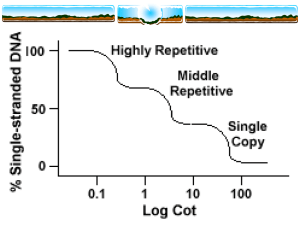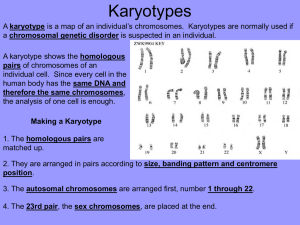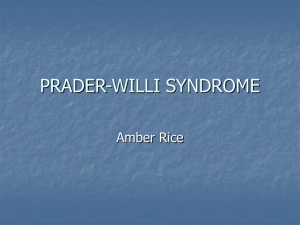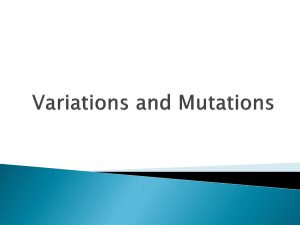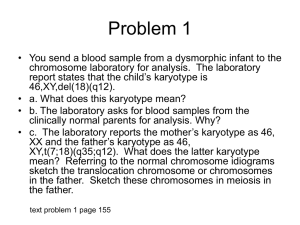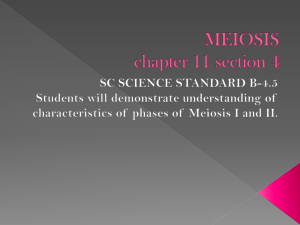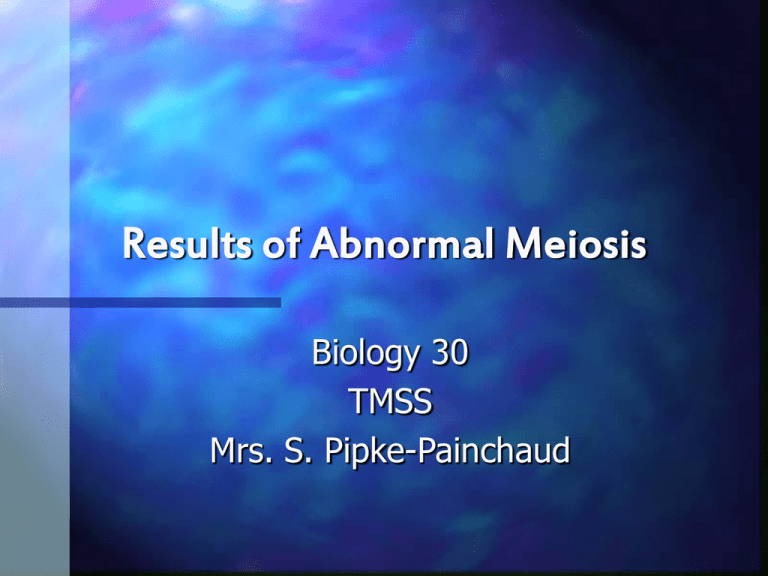
Results of Abnormal Meiosis
Biology 30
TMSS
Mrs. S. Pipke-Painchaud
Definitions
Karyotype:
– a method used to organize the
chromosomes of a cell in relation to
number, size and type.
– Human Karyotype:
http://www.people.virginia.edu/~rjh9u/karyotyp.html
– The Biology Project - Karyotyping activity:
http://www.biology.arizona.edu/human_bio/activities/karyotyping/k
aryotyping.html
– Google Image Search:
http://images.google.ca/images?q=karyotype&hl=en
Chromosomal Mutations
“changes in genetic material that
involve entire chromosomes or pieces of
them” (Addison Wesley 157)
Types of Mutations: (structural)
– DELETION: one or more genes is lost
from the chromosome
ABCDE --> ABDE
DUPLICATION: during meiosis an
unequal crossover occurs and it
receives an extra copy from its partner
chromosome.
– ABCDE --> ABBCDE
TRANSLOCATION: a whole or an
entire piece of a chromosome attaches
to a different pair.
– ABCDE --> ABCXYZDE
INVERSION: a piece of a chromosome
breaks free, turns around and
reattaches itself.
– ABCDEFGHI--> ABCDIHGFE
Changing Chromosome
Number
Nondisjunction: “failure of chromatids
or chromosomes to separate during cell
division” (Addison Wesley 158).
What happens when this occurs in
Mitosis? Or Meiosis?
Mitosis: cell dies, but the organism is not harmed
Meiosis: production of an abnormal gamete; you are
dealing with the production of sex cells and the
possible creation of a new individual.
Abnormal Meiosis
Nondisjunction - mistakes sometimes
occur during meiosis. This occurs when
2 homologous chromosomes move to
the same pole during anaphase I. The
resulting daughter cells either have one
too many chromosomes or one less
chromosome.
Resulting Human Gametes: have 22 or 24 chromosomes. If
fertilized by a normal cell they have 45 and 47
chromosomes.
When an abnormal gamete joins with a
normal gamete . .
.
Monosomy: “zygote receives only one
of a particular type of chromosome
instead of two, as a normal gamete
would” (Addision Wesley 158).
– The zygote has 45 chromosomes.
– One less. (one homologous chromosome
is missing its partner)
Trisomy: “the zygote receives three
chromosomes of a particular type
instead of two” (Addision Wesley 158).
– Zygote has 47 chromosomes
– One extra
Once these cells undergo mitosis, every
cell there after will have an abnormal
number of chromosomes.
In Humans:
Monosomies and trisomies that occur in
embryos are lethal.
– Down Syndrome (47, 21+) is an exception
autosomal trisomy (trisomy 21)
mild to severely disabled
almond shaped eyes
enlarged tongues
short stocky bodies
poor muscle development and coordination
possible heart defects
(A.W. 208)
can lead active, productive lives.
Down Syndrome
Frequency of Down Syndrome births
increase dramatically with the age of
the mother.
– Age 30 = 1/1000
– Age 40 = 1/100
Why?
History of Down Syndrome: Trisomy 21
- the story of Down Syndrome
– http://www.ds-health.com/trisomy.htm
RELATIONSHIP OF DOWN SYNDROME INCIDENCE TO MOTHERS' AGE
Mothers Age
Incidence of Down Syndrome
Under 30
Less than 1 in 1,000
30
1 in 900
35
1 in 400
36
1 in 300
37
1 in 230
38
1 in 180
39
1 in 135
40
1 in 105
42
1 in 60
44
1 in 35
46
1 in 20
48
1 in 16
49
1 in 12
Info from:
National Institute of
Child Health and
Human Development
http://www.nichd.nih.gov/publications/pub
s/downsyndrome/down.htm
Source: Hook, E.G., Lindsjo, A. Down Syndrome in Live Births by Single Year
Maternal Age.
Cause: Random error at the 21st
chromosome.
Cannot be inheritied
Familial Down Syndrome - 1 arm of the
21st chromosome is copied to one of
the 21st pairs of chromosomes
(translocation). This type can be
inheritied.
Other Autosomal Trisomies
Patau Syndrome (47, 13+):
– 1-2 per 10 000
– extra copy of the 13th chromosome
– average survival 2.5 days
– brain malformations, mentally challenged
and heart problems
– The fetus.net http://www.thefetus.net/page.php?id=1473
Edwards Syndrome (47, 18+):
– 1 in every 6000-8000 live births
– severely affects internal organs
– less than 5% survive >1year
– found more often in females
– e-medicine: http://www.emedicine.com/ped/topic652.htm
Polyploidy
“nondisjunction occurs in all the pairs of
chromosomes at once. A polyploidy
organism has three or more entire sets
of chromosomes.” (Addison Wesley
159).
– In animals, it is lethal.
– In plants, it can produce a stronger and
more useful plant with larger flowers and
fruit.
Can occur naturally or in a lab setting.
Approx. 25-50% of plant species are
polyploid. (A.W. 159)
– Triticum aestivum - wheat (bread) 42
chromosomes
originated 8000 years ago
a hybrid of ancient wheat (28) and wild grass
(14)
Potatoes
Other Examples
Oats
– ~ Addison Wesley 159
Polyploid Examples
Back
Normal = 2n or diploid
Triploid (3n) - sterile
– potatoes (larger), bananas (soft seeds wild bananas have hard seeds), seedless
water melons
Tetraploid (4n)
– alfalfa, coffee, peanuts, Macintosh Apples,
white potato, tobacco, cotton
Others:
– Octaploid Strawberries, Oats (6n)
Polyploidy in animals
– although most often fatal examples do
exist in some insects, fish, amphibians and
reptiles.
– Only one mammalian examples exists:
Argentinean Rat (4n = 102)
–
http://users.rcn.com/jkimball.ma.ultranet/BiologyPages/P/Polyploidy.html
– some salmon, African Frogs
(MadSci.nethttp://www.madsci.org/posts/archives/Apr2003/1049863034.Cb.r.html
Nondisjunction of the Sex
Chromosomes
Turner’s Syndrome (45, X):
– monosomy
– born female, short, webbed neck, broad
shield like chest
– 1 in 3000 female births
normal in childhood, normal intelligence.
Adolescence: never reach normal height, do
not develop sexually and are sterile. (A.W. 209)
– Turner Syndrome Society:
us.org/resource/faq.html
http://www.turner-syndrome-
Klinefelter Syndrome (47, xxy)
Trisomy; 1 in 700
tall, male, sterile
underdeveloped testes, can cause some
feminine features (I.e. body shape, breast
development) (A.W. 208)
can also karyotype 48 XXXY; 48XXYY; 49
XXXXY
– y chromosome determines maleness; absence
of y = female (Turner’s Syndrome)
– may be some developmental delays (especially in the area of language)
(National Institute of Health - http://www.nichd.nih.gov/publications/pubs/klinefelter.htm#xwhat)
Defective Chromosome
Structure
Cri-du-chat Syndrome:
– significant deletion from chr 5
– baby’s cry sounds like a cat’s meow
– small heads
– severely developmentally disabled
– rarely live past 1 or 2
– (A.W. 209)
– 1 in 20 000 to 50 000 births (Genetics
Home Reference:
http://ghr.nlm.nih.gov/condition=criduchatsyndrome#definition
Single Allele Disorders
Gene Mutations: (point mutations)
– mutations of a single gene because of
small errors in the sequence of or number
of nucleotides which cause a change in
amino acids.
GGU --> GGU
CCA --> CAA
Recessive Genetic Disorders
Tay Sachs Disease:
– fatal; inability to break down a lipid; causes
an accumulation in the brain = blindness,
then seizures
– death occurs within the first year of life
– higher rate in Ashkenzai Jews (Central
Europe)
– (A.W. 210)
Cystic fibrosis:
– mutation that causes an excessive amount
of mucous to be released by the pancreas,
lungs and other organs.
– Leads to blocked digestive tract, congested
lungs and other pnemonia like infections
– No treatment = death at early age
– Treatment can prolong life until adulthood
Dominant Allele Disorders
Are less common . . . Why?
– Because individuals die before reproducing
Huntington’s Disease:
– fatal disorders that results in deterioration
of the brain and nervous system
– symptoms appear in later 30s and early
40s
– already passed gene onto children
– (A.W. 211)
Other Dominant Alleles
Codominant Disorders
Sickle Cell Disease
– Hemoglobin A = Normal
– Hemoglobin S = Sickle Cell
– both are codominant
an attack begins with a lack of oxygen, HemS
cells form long chains. The RBC become sickle
shaped and tangle. The clumped cells will clog
capillaries and stop blood flow. Sickling crisis is
very painful and may cause death.
High incidence in Africa and the Middle East
because being heterozygous offers some
resistance to malaria. (A.W. 211-212)
Is it possible to have an
XY female or an XX male?
Yes
– on the Y chromosome there is an SRY
Region (Sex Determining Region), which is
responsible for male development. If this
regions gets translocated to an X it will
cause Maleness.
XY Female - SRY region is missing
XX Male - SRY region translocated to X
Autosomal vs Sex Chromosome
Trisomies
In 1961, Mary Lyon proposed that early
on in development of a normal female,
one X chromosome in each body cell is
inactivated.
She suggested the inactive X
chromosome was the darkly staining
mass, called a Barr Body that normally
appears in the nuclei of female cells.
– Thus, one reason sex chromosomes
trisomies are less disruptive is because all
of the extra X chromosomes are inactivated
except for a few active genes.
Example: Calico and Tortoise Shell cats are
always female. WHY?
- Heterozygous - X inactivation is random
- one X (Orange) one X (Black); where ever an orange X is
inactivated the black will show. If the Black X is inactivated the
orange color will show. When the cells go through mitosis and
grow, the cat develops patches of black fur and patches of
orange fur.
Examples of Dominant Alleles
Dimples
freckles
widow’s peak
farsightedness
broad lips
polydactyly (extra digits)
Back
Why does it increase with the
mother’s age?
– All primary oocytes are formed by birth
– once ovulation begins each succeeding
oocyte has been stopped in meiosis for a
progressively longer period of time
– older primary oocyte means a greater
chance of deterioration or exposure to
other harmful elements.
Back
Other Genetic Disorders
Color Blindness (Sex Linked)
Muscular Dystrophy
Hemophilia (Sex Linked)



